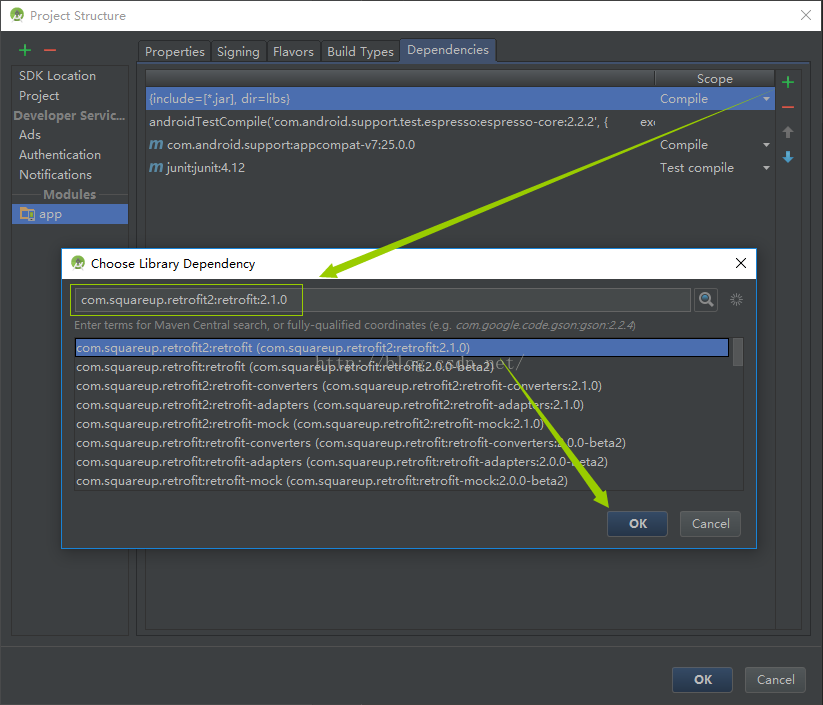編輯:關於Android編程
1、養成好習慣,配置字符串資源文件 strings.xml
xml version="1.0" encoding="utf-8"?>
<resources>
<string name="app_name">網絡圖片查看器</string>
<string name="action_settings">Settings</string>
<string name="hello_world">Hello world!</string>
<string name="imgpath">輸入圖片地址:</string>
<string name="getBtn">獲取圖片</string>
<string name="error">獲取圖片失敗</string>
</resources>
<?xml version="1.0" encoding="utf-8"?>
<resources>
<string name="app_name">網絡圖片查看器</string>
<string name="action_settings">Settings</string>
<string name="hello_world">Hello world!</string>
<string name="imgpath">輸入圖片地址:</string>
<string name="getBtn">獲取圖片</string>
<string name="error">獲取圖片失敗</string>
</resources>
2、布局文件,使用垂直布局
LinearLayout xmlns:android="http://schemas.android.com/apk/res/android"
xmlns:tools="http://schemas.android.com/tools"
android:orientation="vertical"
android:layout_width="match_parent"
android:layout_height="match_parent"
android:paddingBottom="@dimen/activity_vertical_margin"
android:paddingLeft="@dimen/activity_horizontal_margin"
android:paddingRight="@dimen/activity_horizontal_margin"
android:paddingTop="@dimen/activity_vertical_margin"
tools:context=".MainActivity" >
<TextView
android:layout_width="fill_parent"
android:layout_height="wrap_content"
android:text="@string/imgpath"
/>
<EditText android:layout_width="fill_parent"
android:layout_height="wrap_content"
android:id="@+id/imgpathInput"
android:text="http://avatar.csdn.net/B/E/7/1_gaotong2055.jpg"
android:inputType="text" />
<Button
android:layout_width="wrap_content"
android:layout_height="wrap_content"
android:text="@string/getBtn"
android:id="@+id/getBtn"
/>
<ImageView
android:layout_width="wrap_content"
android:layout_height="wrap_content"
android:id="@+id/imgView"
/>
</LinearLayout>
<LinearLayout xmlns:android="http://schemas.android.com/apk/res/android"
xmlns:tools="http://schemas.android.com/tools"
android:orientation="vertical"
android:layout_width="match_parent"
android:layout_height="match_parent"
android:paddingBottom="@dimen/activity_vertical_margin"
android:paddingLeft="@dimen/activity_horizontal_margin"
android:paddingRight="@dimen/activity_horizontal_margin"
android:paddingTop="@dimen/activity_vertical_margin"
tools:context=".MainActivity" >
<TextView
android:layout_width="fill_parent"
android:layout_height="wrap_content"
android:text="@string/imgpath"
/>
<EditText android:layout_width="fill_parent"
android:layout_height="wrap_content"
android:id="@+id/imgpathInput"
android:text="http://avatar.csdn.net/B/E/7/1_gaotong2055.jpg"
android:inputType="text" />
<Button
android:layout_width="wrap_content"
android:layout_height="wrap_content"
android:text="@string/getBtn"
android:id="@+id/getBtn"
/>
<ImageView
android:layout_width="wrap_content"
android:layout_height="wrap_content"
android:id="@+id/imgView"
/>
</LinearLayout>
、編寫代碼
這裡為了方便看代碼,都寫在一個類裡面了。
可以把裡面的靜態方法單獨拆分出來,寫在一個工具類中,結構更好。
public class MainActivity extends Activity implements OnClickListener {
private EditText pathText;
private ImageView imageView;
@Override
protected void onCreate(Bundle savedInstanceState) {
super.onCreate(savedInstanceState);
setContentView(R.layout.activity_main);
pathText = (EditText) this.findViewById(R.id.imgpathInput);
imageView = (ImageView) this.findViewById(R.id.imgView);
Button button = (Button) this.findViewById(R.id.getBtn);
button.setOnClickListener(this);
}
@Override
public boolean onCreateOptionsMenu(Menu menu) {
getMenuInflater().inflate(R.menu.main, menu);
return true;
}
@Override
public void onClick(View v) {
String path = pathText.getText().toString();
byte[] data = null;
try {
data = getImgData(path);
} catch (Exception e) {
e.printStackTrace();
Toast.makeText(this, R.string.error, 1).show();
}
Bitmap bitmap = BitmapFactory.decodeByteArray(data, 0, data.length);
imageView.setImageBitmap(bitmap);
}
public static byte[] getImgData(String path) throws Exception {
URL url = new URL(path);
HttpURLConnection conn = (HttpURLConnection) url.openConnection();
conn.setConnectTimeout(5000);// 超時時間5秒
conn.setRequestMethod("GET");
if (conn.getResponseCode() == 200) {
InputStream in = conn.getInputStream();
return read(in);
} else {
Log.d("tong.getImg", "服務器無響應");
}
return null;
}
/**
* 從一個輸入流中讀取數據,並返回
*
* @param in
* @return byte[] 數據
* @throws IOException
*/
public static byte[] read(InputStream in) throws IOException {
// 開辟一個內存的區域,以寫入數據
ByteArrayOutputStream outStream = new ByteArrayOutputStream();
byte[] buffer = new byte[10240];
int len = 0;
while ((len = in.read(buffer)) != -1) {
outStream.write(buffer, 0, len);
}
outStream.close();
return outStream.toByteArray(); // 返回內存中的數據
}
}
public class MainActivity extends Activity implements OnClickListener {
private EditText pathText;
private ImageView imageView;
@Override
protected void onCreate(Bundle savedInstanceState) {
super.onCreate(savedInstanceState);
setContentView(R.layout.activity_main);
pathText = (EditText) this.findViewById(R.id.imgpathInput);
imageView = (ImageView) this.findViewById(R.id.imgView);
Button button = (Button) this.findViewById(R.id.getBtn);
button.setOnClickListener(this);
}
@Override
public boolean onCreateOptionsMenu(Menu menu) {
getMenuInflater().inflate(R.menu.main, menu);
return true;
}
@Override
public void onClick(View v) {
String path = pathText.getText().toString();
byte[] data = null;
try {
data = getImgData(path);
} catch (Exception e) {
e.printStackTrace();
Toast.makeText(this, R.string.error, 1).show();
}
Bitmap bitmap = BitmapFactory.decodeByteArray(data, 0, data.length);
imageView.setImageBitmap(bitmap);
}
public static byte[] getImgData(String path) throws Exception {
URL url = new URL(path);
HttpURLConnection conn = (HttpURLConnection) url.openConnection();
conn.setConnectTimeout(5000);// 超時時間5秒
conn.setRequestMethod("GET");
if (conn.getResponseCode() == 200) {
InputStream in = conn.getInputStream();
return read(in);
} else {
Log.d("tong.getImg", "服務器無響應");
}
return null;
}
/**
* 從一個輸入流中讀取數據,並返回
*
* @param in
* @return byte[] 數據
* @throws IOException
*/
public static byte[] read(InputStream in) throws IOException {
// 開辟一個內存的區域,以寫入數據
ByteArrayOutputStream outStream = new ByteArrayOutputStream();
byte[] buffer = new byte[10240];
int len = 0;
while ((len = in.read(buffer)) != -1) {
outStream.write(buffer, 0, len);
}
outStream.close();
return outStream.toByteArray(); // 返回內存中的數據
}
}
 android基於ListView和CheckBox實現多選和全選記錄的功能
android基於ListView和CheckBox實現多選和全選記錄的功能
應用開發中經常會有從數據庫中讀取數據顯示,然後選中多條、全部記錄並且刪除的需求。在做定制系統聯系人的時候也遇到這樣的需求,下面寫個簡單的通過ListView和CheckB
 Android開發者需要知道的8個項目管理技巧
Android開發者需要知道的8個項目管理技巧
專業的Android app開發人員會關注一些成熟的項目管理技術,以成功構建Android app,並讓這個app在Google Play Store嶄露頭角。考慮高端客
 android:修改PagerTabStrip中的背景顏色,標題字體的樣式、顏色和圖標以及指示條的顏色
android:修改PagerTabStrip中的背景顏色,標題字體的樣式、顏色和圖標以及指示條的顏色
1.修改PagerTabStrip中的背景顏色我們在布局中直接設置background屬性即可: 2.修改指示條的顏色我們可以在java代碼中
 Android開發-Retrofit-AndroidStudio(一)百度首頁解析
Android開發-Retrofit-AndroidStudio(一)百度首頁解析
有能力的同學可以直接去看 Retrofit官方Demo:https://github.com/square/retrofit我這邊簡單使用一下,以百度首頁解析作為開篇:導